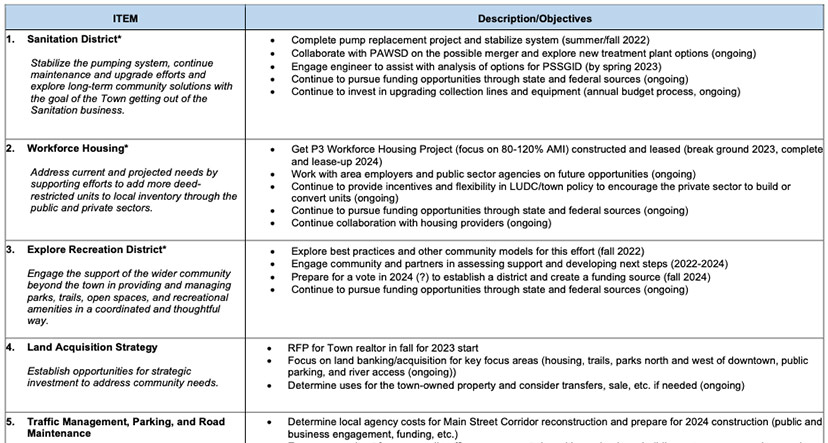In preparation for last night’s (December 6) Town Council meeting at Town Hall, I had met with several Council members to discuss some details of the proposed 2023 Town budget — specifically, whether the budget fully reflected the Council’s adopted “Goals for 2022-2023” as adopted and published last summer.
You can download those “Goals” here.
I was especially interested in discussing the two high priority goals, as shown below. ‘Sanitation District’ and ‘Workforce Housing’.
Both of those goals had received an * in their titles… indicating “highest priority”.
We’ve written a few stories here in the Daily Post about the Town’s struggles with their seven-mile-uphill sewer pipeline, and we’ve noted the stated intentions — from the Council and staff — to explore “the goal of the Town getting out of the Sanitation business”…
…presumably by convincing the community’s primary sanitation district, PAWSD (Pagosa Area Water and Sanitation District) to collaborate with the Town on an improved (and hopefully less expensive and less troublesome) sanitation system.
The other portion of the Town budget I wanted to discuss with Council members concerned Priority Goal Number 2. “Workforce Housing.” Also marked with an *.
Much of the time spent by Town staff over the past 18 months has been related to this goal — and in particular, to proposed collaboration with Dallas-based student housing developer Servitas to build perhaps 64 ‘workforce housing’ units on Town-owned property. The number of proposed dwelling units increased to 98 units last summer, but progress on the project has been halted while the Town Council and staff assess whether the project is realistic, whether it shares the financial risks fairly, and whether it actually addresses the most pressing housing needs in the community.
The Council and staff may have other questions about the Servitas proposal as well.
One thing I was not able to discuss with Council members last week was the new ‘Vacation Rentals Nexus Study’ from Denver-based Root Policy Research. The report was not posted to the meeting packet until late Friday, so I didn’t have a chance to talk it over with any Council members prior to last night’s meeting.
The document (which you can download here) is actually titled, “Short Term Rental Fee Study”.
One of the interesting things about the Council’s Number 2 Priority Goal for 2022-2023 (at least, I find it interesting) is that it doesn’t specifically mention local funding options.
- Get P3 [Servitas] Workforce Housing Project (focus on 80-120% AMI) constructed and leased (break ground 2023, complete and lease-up 2024)
- Work with area employers and public sector agencies on future opportunities (ongoing)
- Continue to provide incentives and flexibility in LUDC/town policy to encourage the private sector to build or convert units (ongoing)
- Continue to pursue funding opportunities through state and federal sources (ongoing)
- Continue collaboration with housing providers (ongoing)
Yes, the goal mentions “state and federal sources”… but as we can imagine, the competition for state and federal housing grants is rather intense, given the nationwide character of the housing crisis in America.
But how about local funding sources? Do we have taxpayer money currently being spent on [frivolous?] projects, that can be redirected toward our Number One and Number Two Priorities?
Additionally, are there additional revenues sources in the local community that remain ‘untapped’?
These were some of the ideas knocking around in my head, as I walked into the Council meeting room last night.
The Council meeting actually began with a non-Council meeting — a meeting of the Town’s Urban Renewal Authority (URA), the board of which includes the entire Town Council plus a few representatives from other local government taxing districts. The URA, created in 2019 at the request of the Springs Resort, was subject to a fairly severe limitation on its powers, when the town voters amended the Town Home Rule Charter requiring voter approval for any Tax Increment Financing scheme (TIF) used to subsidize private developments like the one proposed by the Springs Resort.
The URA board adopted a budget with zero revenue and zero expenditures. Apparently, the Town doesn’t expect any TIF funding schemes to be proposed during 2023.
I will also mention that the Town’s budget was approved as presented, without any public testimony offered during the hearing.
But the meat of this editorial series is properly focused on the Root Policy Research Short Term Rental Fee Study, a $56,000 report that suggests that a viable ‘impact fee’ of about $2,687 per Short-Term Rental (STR) per year. The mathematics of the fee calculation were very quickly summarized for the Town Council by Mollie Fitzpatrick, Root Policy Managing Director, and her associate Avilia Bueno.
For its calculation of how the growth of the STR industry impacts the affordability of long-term housing in a community, Root Policy apparently used a mathematical tool published in 2021. Or maybe in 2019.
Barron, K., Kung, E., & Proserpio, D. (2021). The effect of home-sharing on house prices and rents: Evidence from Airbnb. Marketing Science, 40(1), 23-47.
Quote from the Root Policy report:
Given that there may still be unobserved factors in the error term that are correlated with Airbnb activity, an instrumental variable is used. This variable needs to be uncorrelated with local housing markets and be correlated with the number of Airbnb listings. The instrument used follows Barron et al. (2019) and measures the volume of Google searches which is then interacted with the number of tourism related establishments in each zip code in 2010… The Google trends measure is interacted with a measure to tourism activity because it is assumed that potential hosts are more likely to rent their property in the short-term market in response to learning about Airbnb. This instrument therefore interacts an exogenous variable with an endogenous exposure variable. Extensive evidence of the validity of the instrument used is presented in the Barron et al. (2019) study.
I can’t pretend to understand what that paragraph means. But if the Town paid $56,000 for this report, it sure as heck must mean something to someone.
Most of the Town Council questions about the report came from Council member Gary Williams, who seems to have considered the 31-page report rather more thoroughly than I had.
Council member Jeff Posey also raised some interesting questions.
Another person who had read the document carefully was a member of the public… my friend Glenn Walsh.


